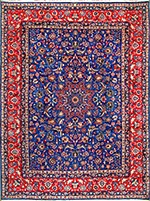Textiles Studies

Textile Research Works
Date of this Version
1993
Document Type
Article
Citation
Studies in the History of Art, 1993, Vol. 42, Monograph Series II: Conservation Research: Studies of Fifteenth- to Nineteenth-Century Tapestry (1993), pp. 104-117.
Abstract
In the largest sense, Oriental rugs represent both the social history and manufacturing traditions of their particular cultures and are related to the human needs, economies, and ecological constraints of those societies. Each textile or fragment represents a complex set of human interactions between user and viewer, implying a social response, and between user and maker, sometimes resulting from economic transactions among buyer and seller, lender, merchant, and trader. Suppliers of raw materials and market superintendents or commissioners for fair trade and quality control may also have been involved. The quality and appearance of any given textile results from the contemporaneous conjunction of such factors as taste, knowledge, technology, social traditions, aesthetic preference, fashion, political and economic circumstances, household organization, availability of raw materials, and ecology of surroundings. In short, every textile ever produced, from oversize carpets to the tiniest scrap of a fragment, is the product of its own environment, made and used in response to a particular set of historical circumstances.
Oriental carpets have long been appreciated in Europe and America. Rich colors and attractive designs, as well as lush pile and renowned durability, have given them a well-deserved reputation as beautiful and useful floor coverings. As handmade products of distant lands, their complicated patterns also evoke the romance of lux- ury and the East of long ago. The familiar Oriental carpets that have graced the parlors and drawing rooms of American middle- class homes are, for the most part, commercially produced and marketed. Less well known are the tribal and ethnographic weavings of peoples of the Near East. Although such rugs have a long history, they have become known in the West only recently. The many varieties of flatweaves, as opposed to pile carpets, are the Near Eastern structural equivalent of European tapestries. Yet flatweaves (rugs without pile) from the Near East are distinctly different from European structural counterparts, probably due primarily to particular circumstances of production and their cultural context. Near Eastern flatweaves were generally woven by and for the people who used them rather than for commercial sale. Worn and well used, and only rarely available in the markets and bazaars of Cairo, Istanbul, Tblisi, and Bokhara, those that survive today were produced in the nineteenth and early twentieth centuries by rural sedentary and nomadic population groups in Anatolia, Persia, the Caucasus, and Central Asia, which today fall within the present borders of Turkey, Iran, and the southern republics of the former Soviet Union.
Included in
Art and Materials Conservation Commons, Art Practice Commons, Fiber, Textile, and Weaving Arts Commons, Indigenous Studies Commons, Museum Studies Commons


Comments
Published by National Gallery of Art.